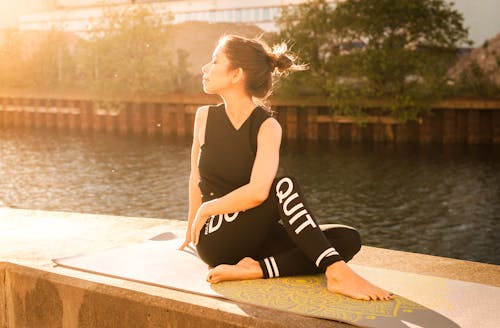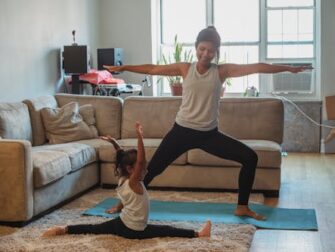Yoga for Stress Relief: Find Calm Amidst the Chaos of Life
Life can be a whirlwind of demands, deadlines, and responsibilities, leaving many of us feeling overwhelmed and stressed. In the midst of this chaos, finding moments of calm can feel like an impossible feat. However, there is a powerful tool that can help us navigate through the storm of stress: yoga.
Yoga is an ancient practice that originated in India and has been around for thousands of years. It combines physical postures, breathing exercises, and meditation to promote relaxation, reduce stress, and enhance overall well-being. In this article, we’ll explore how yoga can be a valuable tool for stress relief, as well as some specific yoga poses and practices you can incorporate into your daily routine.
Understanding Stress and its Impact on the Body
Before we delve into how yoga can help alleviate stress, it’s important to understand what stress is and how it affects our bodies. Stress is a natural response to challenging situations, triggering the body’s “fight or flight” response, which releases hormones like cortisol and adrenaline. While this response is useful in short bursts, chronic stress can take a toll on our physical and mental health.
Chronic stress has been linked to a variety of health problems, including high blood pressure, heart disease, obesity, and depression. It can also manifest as physical symptoms such as muscle tension, headaches, and fatigue. Given the prevalence of stress in modern life, finding effective ways to manage it is essential for our well-being.
The Role of Yoga in Stress Relief
Yoga offers a holistic approach to stress relief, addressing both the physical and mental aspects of stress. Through a combination of movement, breathwork, and mindfulness, yoga helps calm the nervous system, reduce muscle tension, and quiet the mind. Regular practice can cultivate a sense of inner peace and resilience, enabling us to better cope with life’s challenges.
Yoga Poses for Stress Relief
- Child’s Pose (Balasana): Begin by kneeling on the floor with your big toes touching and knees hip-width apart. Slowly lower your torso down, reaching your arms forward with palms resting on the ground. Rest your forehead on the mat and take slow, deep breaths, allowing your body to relax completely.
- Forward Fold (Uttanasana): Stand with your feet hip-width apart and hinge at the hips to fold forward, allowing your upper body to hang over your legs. You can bend your knees as much as needed to release any tension in the lower back. Let your head and neck relax, and breathe deeply into the stretch.
- Cat-Cow Stretch (Marjaryasana-Bitilasana): Come to a tabletop position on your hands and knees. Inhale as you arch your back, lifting your chest and tailbone towards the ceiling (Cow Pose). Exhale as you round your spine, tucking your chin to your chest and drawing your belly button towards your spine (Cat Pose). Flow between these two poses with your breath, moving slowly and mindfully.
- Legs-Up-the-Wall Pose (Viparita Karani): Sit with one side of your body against a wall and gently swing your legs up, resting them against the wall. Adjust your position so that your hips are touching the wall and your body forms an L-shape. Close your eyes and focus on your breath as you relax into the pose. This gentle inversion helps calm the nervous system and promote relaxation.
- Corpse Pose (Savasana): Lie down on your back with your legs extended and arms resting by your sides, palms facing up. Close your eyes and allow your body to completely relax, releasing any tension with each exhale. Stay in this pose for several minutes, focusing on your breath and letting go of any thoughts or worries.
Read More: High-Intensity Training: Push Your Limits and Achieve Breakthrough Results
Breathing Exercises for Stress Relief
In addition to yoga poses, breathing exercises, or pranayama, are an essential component of stress relief in yoga. Deep, diaphragmatic breathing activates the body’s relaxation response, calming the mind and reducing stress levels. Here are two simple breathing techniques you can practice:
- Diaphragmatic Breathing: Sit or lie down in a comfortable position. Place one hand on your belly and the other on your chest. Take a deep breath in through your nose, allowing your belly to rise as you fill your lungs with air. Exhale slowly through your mouth, feeling your belly fall. Continue this slow, deep breathing for several minutes, focusing on the sensation of your breath moving in and out of your body.
- Alternate Nostril Breathing (Nadi Shodhana): Sit comfortably with your spine tall. Use your right thumb to close your right nostril and inhale deeply through your left nostril. At the top of your inhale, close your left nostril with your right ring finger, and exhale through your right nostril. Inhale through the right nostril, then close it and exhale through the left nostril. Continue this pattern, alternating nostrils with each breath. This technique balances the nervous system and promotes a sense of calm.
Conclusion
In today’s fast-paced world, stress has become an inevitable part of life. However, with the practice of yoga, we can learn to manage our stress more effectively and cultivate a greater sense of inner peace and well-being. By incorporating yoga poses, breathing exercises, and mindfulness practices into our daily routine, we can find calm amidst the chaos of life, allowing us to live with greater balance and resilience. So, roll out your yoga mat, take a deep breath, and let go of stress one pose at a time.



